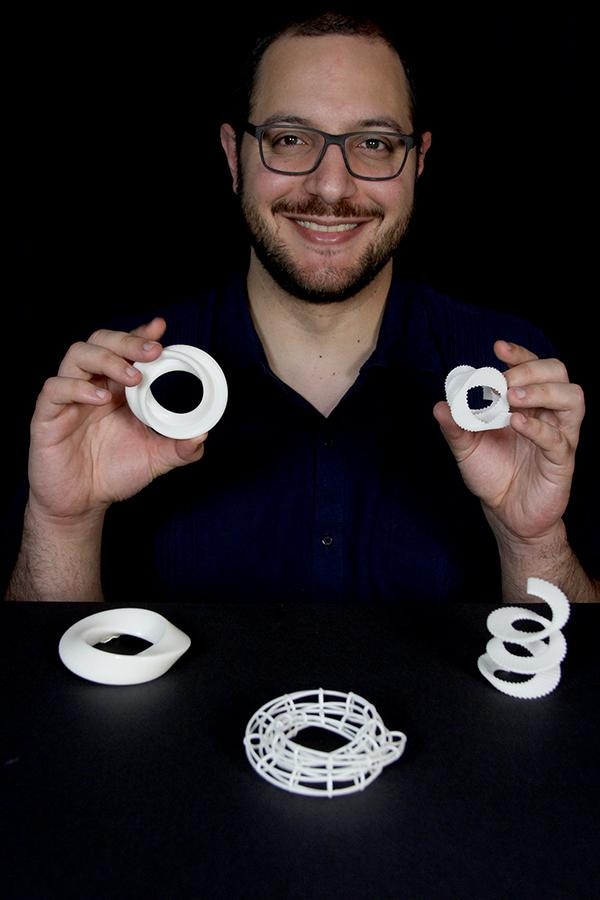Jun 11 2019
Generally, humans learn to tie their shoelaces when they are approximately six years old, making ribbon-like knots, or perhaps, more complex ones, if they are a bit clumsy.
 ICFO researcher and first author, Emilio Pisanty, with pieces that represent the different knotted configurations. (Image credit: ICFO)
ICFO researcher and first author, Emilio Pisanty, with pieces that represent the different knotted configurations. (Image credit: ICFO)
Knots are used on a daily basis, but the types of knots that are normally used are related to physical objects, that is, things that can be touched.
Even though it can be difficult to image, light can be molded in ways that result in knotted configurations, the shape of which is dependent on the light’s orbital angular momentum. This parameter is accountable for making the light beam to twist around its own axis, creating various shapes of knots, and increasing to a new degree of freedom that can carry useful data.
Over the past two decades, understanding and mastering the way to create twisted light—that is, light with orbital angular momentum—has been a flourishing field of study. Orbital angular momentum is different from spin angular momentum, because the former is related to the spatial distribution of the electric field and the latter is related to the polarization of light. It is also possible to couple these two types of angular momentum, leading to an array of light fields of varied shapes with polarizations that alter from one point to another.
The light’s behavior also gets richer when it travels from oscillating at a single frequency (monochromatic light) to vibrating at several varied frequencies. This brings about a wide range of polarization states, each elucidating a shape that can be easily traced by the light’s electric field over time. When this broader space of possibilities is integrated with the spatial differences generated by the orbital angular momentum, even more space should be produced for fascinating connections. However, until now, this has remained an unexplored frontier—although extensive research has been done on structured light, it has been mainly concentrated on single-color fields.
In a new study, reported in a couple of papers, joint associations by ICFO scientists have broken experimental and theoretical ground in this new domain, exposing new kinds of knots for twisted light as well as a novel form of angular momentum.
In the first paper, reported in Nature Photonics, the ICFO researchers that included Gerard Jiménez Machado, Emilio Pisanty, Alessio Celi, Antonio Picón, and Veronica Vicuña Hernández, headed by UPC Professor at ICFO Juan P. Torres and ICREA Professor at ICFO Maciej Lewenstein, have created a light beam with a polarization state that forms three-lobed trefoils at every point, and they did this by integrating light of varied frequencies (w and 2 w), and making the trefoils link to one another in such a way that the beam of light, as a whole, takes the shape of a knot.
Moreover, these light beams display a new type of angular momentum, related to the unfamiliar symmetry of the beams, which stay invariant under rotations, but only when a certain fraction of the rotation of the spatial dependence rotates the polarization. This new quantity was called the torus-knot angular momentum by the team, owing to the type of knot in the beams.
In addition, the scientists implemented these beams at an experimental level, utilizing nonlinear crystals to produce the light beams, and they also developed a nonlinear polarization tomography scheme in order to determine the trefoil shapes that are traced by the electric field. The researchers’ measurements revealed the presence of a novel type of optical singularity, which is powerful and topologically protected against perturbations, induced by the varied orientation of the polarization trefoils at varied points around a circularly-polarized center.
In the second paper, reported in Physical Review Letters, the ICFO team Antonio Picón and Emilio Pisanty, headed by Maciej Lewenstein, an ICREA Professor at ICFO, in association with scientists from CU Boulder and from the Laser Applications and Photonics group at the University of Salamanca, demonstrated that this novel optical singularity can be used on nonlinear optics, even in non-perturbative situations and at the high-intensity extremes.
There the team demonstrated, through hypothetical simulations, that the high-order harmonics generated by the torus-knot beams at extremely high intensities are able to maintain the driving laser’s coordinated symmetry, producing twisted spirals of ultra-short pulses of light, and that the angular momentum of torus-knot beams is preserved in the interaction. This novel symmetry is important for interpreting the production of shaped light at extremely short wavelengths, which can be employed for new applications in spectroscopy, lithography, and microscopy.
The outcomes of both studies offer new results and frameworks that advance the analysis of non-linear optics and structured light. The team was able to find innovative conservation laws for non-linear optics which appeared to hold even in adverse situations where a countless number of photons get integrated to create single high-frequency photons. However, the researchers also examined the driving fields that make this viable and demonstrated that they include a novel optical singularity, with a novel degree of freedom that can possibly be used for storing useful data, thus paving the way for applying these innovative topologies of light for many futuristic applications, including communication applications.